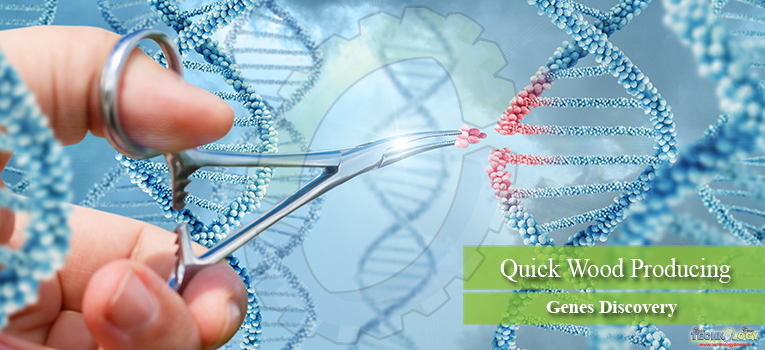The wood tissues of trees is composed of xylem cells that arise from divisions of stem cells within the cambial meristem. The rate of xylem cell formation is dependent upon the rate of cell division within the cambium and is controlled by both genetic and environmental factors .

Scientists have discovered a way to make trees grow bigger and faster, which could increase supplies of renewable resources and help trees cope with the effects of climate change.
In the annual plant Arabidopsis, signaling between a peptide ligand CLE41 and a receptor kinase PXY controls cambial cell divisions
Over expression of PttPXY and PttCLE41 genes in hybrid aspen resulted in vascular tissue abnormalities and poor plant growth. In contrast, precise tissue-specific over expression generated trees that exhibited a 2-fold increase in the rate of wood formation, were taller, and possessed larger leaves compared to the controls.
Our results demonstrate that the PXY-CLE pathway has evolved to regulate secondary growth and manipulating this pathway can result in dramatically increased tree growth and productivity
How gene works
Wood is composed of xylem cells that arise from divisions of stem cells that reside within the vascular meristem, known as the cambium or procambium. One mechanism that promotes cell division in vascular meristems of Arabidopsis involves phloem-specific expression of CLE41 that encodes a peptide ligand known as TDIF.
TDIF is perceived by a receptor kinase, PXY (also known as TDR), that is expressed in the adjacent stem cells of the procambium PXY controls both the orientation and rate of cell division in procambial stem cells and inhibits their differentiation into xylem .
Consequently, while ectopically overexpressing CLE41 in Arabidopsis increases the number of cells in vascular bundles, these increases are accompanied by repression of xylem differentiation and loss of vascular organization
Future Applications
”Trees grow more quickly and so will contribute to meeting the needs for increased plant biomass as a renewable source of biofuels, chemicals and materials while minimizing further CO2 release into the atmosphere,”
Trees represent a huge natural resource used for the production of paper, fuel, and materials and are an increasingly important carbon sink that can help to ameliorate anthropogenic increases in atmospheric CO2. Recently, trees have also been the focus of intense interest as a renewable source of plant biomass that may be converted into bioethanol and other chemicals for the rapidly expanding field of industrial biotechnology.
The majority of biomass in trees is derived from radial growth that is characterized by growth rings in the wood. The size of each growth ring is intimately linked to the environmental conditions during the growing season that year.
While tree productivity may benefit from anthropogenic increases in atmospheric CO2, climate models and recent changes in weather pattern strongly suggest that we are entering a period in which large parts of the globe experience more frequent exposure to extreme and changeable weather that is likely to have detrimental effects on growth.
It will be important to establish whether manipulating PXY-CLE signaling will enable us to override the environmental cues that normally regulate plant growth and thus enable us to generate trees that are able to maintain high productivity even when exposed to more extreme environmental conditions.